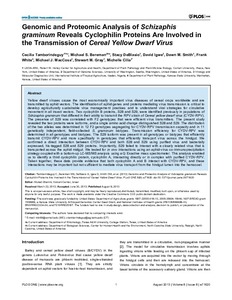| dc.contributor.author | Tamborindeguy, C. |
| dc.contributor.author | Bereman, M. |
| dc.contributor.author | DeBlasio, S. |
| dc.contributor.author | Igwe, D. |
| dc.contributor.author | Smith, M. |
| dc.contributor.author | White, F. |
| dc.contributor.author | MacCoss, M. |
| dc.contributor.author | Gray, S. M. |
| dc.contributor.author | Cilia, M. |
| dc.date.accessioned | 2019-12-04T11:03:43Z |
| dc.date.available | 2019-12-04T11:03:43Z |
| dc.date.issued | 2013-08 |
| dc.identifier.citation | Tamborindeguy, C., Bereman, M., DeBlasio, S., Igwe, D., Smith, M., White, F., ... & Cilia, M. (2013). Genomic and proteomic analysis of Schizaphis graminum reveals cyclophilin proteins are involved in the transmission of cereal yellow dwarf virus. PloS one 8(8):e71620. |
| dc.identifier.issn | 1932-6203 |
| dc.identifier.uri | https://hdl.handle.net/20.500.12478/1207 |
| dc.description.abstract | Yellow dwarf viruses cause the most economically important virus diseases of cereal crops worldwide and are transmitted by aphid vectors. The identification of aphid genes and proteins mediating virus transmission is critical to develop agriculturally sustainable virus management practices and to understand viral strategies for circulative movement in all insect vectors. Two cyclophilin B proteins, S28 and S29, were identified previously in populations of Schizaphis graminum that differed in their ability to transmit the RPV strain of Cereal yellow dwarf virus (CYDV-RPV). The presence of S29 was correlated with F2 genotypes that were efficient virus transmitters. The present study revealed the two proteins were isoforms, and a single amino acid change distinguished S28 and S29. The distribution of the two alleles was determined in 12 F2 genotypes segregating for CYDV-RPV transmission capacity and in 11 genetically independent, field-collected S. graminum biotypes. Transmission efficiency for CYDV-RPV was determined in all genotypes and biotypes. The S29 isoform was present in all genotypes or biotypes that efficiently transmit CYDV-RPV and more specifically in genotypes that efficiently transport virus across the hindgut. We confirmed a direct interaction between CYDV-RPV and both S28 and S29 using purified virus and bacterially expressed, his-tagged S28 and S29 proteins. Importantly, S29 failed to interact with a closely related virus that is transported across the aphid midgut. We tested for in vivo interactions using an aphid-virus co-immunoprecipitation strategy coupled with a bottom-up LC-MS/MS analysis using a Q Exactive mass spectrometer. This analysis enabled us to identify a third cyclophilin protein, cyclophilin A, interacting directly or in complex with purified CYDV-RPV. Taken together, these data provide evidence that both cyclophilin A and B interact with CYDV-RPV, and these interactions may be important but not sufficient to mediate virus transport from the hindgut lumen into the hemocoel. |
| dc.description.sponsorship | United States Department of Agriculture |
| dc.format.extent | e71620 |
| dc.language.iso | en |
| dc.subject | Cereal Crops |
| dc.subject | Plant Diseases |
| dc.subject | Monocots |
| dc.subject | Aphid |
| dc.subject | Genomic |
| dc.title | Genomic and proteomic analysis of Schizaphis graminum reveals cyclophilin proteins are involved in the transmission of cereal yellow dwarf virus |
| dc.type | Journal Article |
| dc.description.version | Peer Review |
| cg.contributor.affiliation | Cornell University |
| cg.contributor.affiliation | University of Washington |
| cg.contributor.affiliation | International Institute of Tropical Agriculture |
| cg.contributor.affiliation | Kansas State University |
| cg.isijournal | ISI Journal |
| cg.authorship.types | CGIAR and advanced research institute |
| cg.iitasubject | Cereal Crops |
| cg.iitasubject | Plant Diseases |
| cg.journal | PloS one |
| cg.howpublished | Formally Published |
| cg.accessibilitystatus | Open Access |
| local.dspaceid | 78455 |
| cg.targetaudience | Scientists |
| cg.identifier.doi | https://dx.doi.org/10.1371/journal.pone.0071620 |

